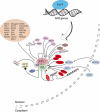Recent advances in the regulation of plant miRNA biogenesis
- PMID: 33666136
- PMCID: PMC8632083
- DOI: 10.1080/15476286.2021.1899491
Recent advances in the regulation of plant miRNA biogenesis
Abstract
MicroRNAs (miRNAs) are essential non-coding riboregulators of gene expression in plants and animals. In plants, miRNAs guide their effector protein named ARGONAUTE (AGO) to find target RNAs for gene silencing through target RNA cleavage or translational inhibition. miRNAs are derived from primary miRNA transcripts (pri-miRNAs), most of which are transcribed by the DNA-dependent RNA polymerase II. In plants, an RNase III enzyme DICER-LIKE1-containing complex processes pri-miRNAs in the nucleus into miRNAs. To ensure proper function of miRNAs, plants use multiple mechanisms to control miRNA accumulation. On one hand, pri-miRNA levels are controlled through transcription and stability. On the other hand, the activities of the DCL1 complex are regulated by many protein factors at transcriptional, post-transcriptional and post-translational levels. Notably, recent studies reveal that pri-miRNA structure/sequence features and modifications also play important roles in miRNA biogenesis. In this review, we summarize recent progresses on the mechanisms regulating miRNA biogenesis.
Keywords: Plant miRNA biogenesis; dcl1; pri-miRNA processing; pri-miRNA stability; pri-miRNA transcription.
Conflict of interest statement
No potential conflicts of interest were disclosed.
Figures
Similar articles
-
New insights into pri-miRNA processing and accumulation in plants.Wiley Interdiscip Rev RNA. 2015 Sep-Oct;6(5):533-45. doi: 10.1002/wrna.1292. Epub 2015 Jun 29. Wiley Interdiscip Rev RNA. 2015. PMID: 26119101 Review.
-
Biogenesis, turnover, and mode of action of plant microRNAs.Plant Cell. 2013 Jul;25(7):2383-99. doi: 10.1105/tpc.113.113159. Epub 2013 Jul 23. Plant Cell. 2013. PMID: 23881412 Free PMC article. Review.
-
Widespread changes to the translational landscape in a maize microRNA biogenesis mutant.Plant J. 2024 Aug;119(4):1986-2000. doi: 10.1111/tpj.16902. Epub 2024 Jul 4. Plant J. 2024. PMID: 38963711
-
Expression of microRNAs and its regulation in plants.Semin Cell Dev Biol. 2010 Oct;21(8):790-7. doi: 10.1016/j.semcdb.2010.03.012. Epub 2010 Apr 18. Semin Cell Dev Biol. 2010. PMID: 20403450 Free PMC article. Review.
-
microRNA biogenesis, degradation and activity in plants.Cell Mol Life Sci. 2015 Jan;72(1):87-99. doi: 10.1007/s00018-014-1728-7. Epub 2014 Sep 11. Cell Mol Life Sci. 2015. PMID: 25209320 Free PMC article. Review.
Cited by
-
MicroRNAs Are Involved in Regulating Plant Development and Stress Response through Fine-Tuning of TIR1/AFB-Dependent Auxin Signaling.Int J Mol Sci. 2022 Jan 3;23(1):510. doi: 10.3390/ijms23010510. Int J Mol Sci. 2022. PMID: 35008937 Free PMC article. Review.
-
Dual Catalytic Hairpin Assembly-Based Automatic Molecule Machine for Amplified Detection of Auxin Response Factor-Targeted MicroRNA-160.Molecules. 2021 Oct 25;26(21):6432. doi: 10.3390/molecules26216432. Molecules. 2021. PMID: 34770841 Free PMC article.
-
Role of non-coding RNAs in quality improvement of horticultural crops: computational tools, databases, and algorithms for identification and analysis.Funct Integr Genomics. 2025 Apr 4;25(1):80. doi: 10.1007/s10142-025-01592-3. Funct Integr Genomics. 2025. PMID: 40183947 Review.
-
What Do We Know about Barley miRNAs?Int J Mol Sci. 2022 Nov 25;23(23):14755. doi: 10.3390/ijms232314755. Int J Mol Sci. 2022. PMID: 36499082 Free PMC article.
-
Machine learning provides specific detection of salt and drought stresses in cucumber based on miRNA characteristics.Plant Methods. 2023 Nov 8;19(1):123. doi: 10.1186/s13007-023-01095-x. Plant Methods. 2023. PMID: 37940966 Free PMC article.
References
-
- Li S, Castillo-Gonzalez C, Yu B, et al. The functions of plant small RNAs in development and in stress responses. Plant J. 2017;90(4):654–670. - PubMed
-
- Song X, Li Y, Cao X, et al. Micrornas and their regulatory roles in plant-environment interactions. Annu Rev Plant Biol. 2019;70(1):489–525. - PubMed
-
- Manavella PA, Yang SW, Palatnik J. Keep calm and carry on: miRNA biogenesis under stress. Plant J. 2019;99(5):832–843. - PubMed
Publication types
MeSH terms
Substances
Grants and funding
LinkOut - more resources
Full Text Sources
Other Literature Sources



